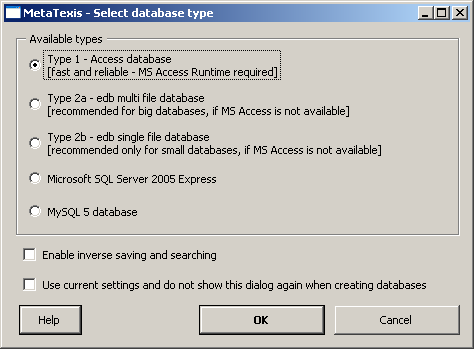
MetaTexis can use two types of professional database engines to save and administer local databases which are saved on your computer: Microsoft Access/Jet Engine (type 1) or edb (type 2). For this reason, it is ensured that your TM and TDB data are saved quickly and safely, for database engines are optimized for saving and searching data. Even in the case of a computer breakdown, the data will usually not get lost.
If the Microsoft Jet Engine is available on your computer, you are advised to use this engine, for it is very fast and reliable. The Jet Engine is also used by Microsoft Access.
To set the database type, click the Set database type menu command (for creating new databases):

To create a database, select one type by clicking a radio button and click OK. Then, a dialog will be shown where you can define a name and choose a directory.
Three database types are available:
· Type 1 - Access database
MS Access databases are fast and reliable. If MS Access or the MS Access runtime files (included in the MS Office Small Business Edition) are available on your system, both TMs and TDBs can be created and maintained using the Microsoft Access database engine (also called "Jet" engine). The Jet engine is regularly updated by Microsoft. Please check the Microsoft Windows Update internet page, to see whether an update is available for your system.
You are advised to regularly compress your main TM/TDB by clicking the menu command Compress main TM or Compress main TDB.
A TM is saved as a file with the extension ".mxa" while a TDB is saved as a file with the extension ".mxt". These files contain all relevant information, including all indexes. Therefore, to copy a TM or a TDB to another location, you only need to copy one file.
· Type 2a - edb multi-file database
This is the fastest and most reliable database type. The drivers ship with the MetaTexis installation so that this type can run on every system where MetaTexis 2 is installed.
If MS Access is not available and, if you intend to have big translation memories or terminology databases, please use this type.
The database itself consists of about 15 files rather than one; therefore you are strongly advised to create it in a special sub-directory for it which only contains the database files and nothing else.
· Type 2b - edb single-file database
This type is very similar to the 2a type, the only difference being that all information is saved in one single file. For this reason, it is easy to transfer the database to other directories or computers. So, if you expect this to happen often, this type is recommended. The disadvantage of this database type can be bigger database size compared to the 2a driver.
· Microsoft SQL Server 2005 Express
This engine is the freeware version of the professional Microsoft SQL Server. It is highly reliable, but the size of databases is limited to 4 Gigabytes (which is quite a lot for freelancers). The engine can be downloaded for free at this location:
http://msdn.microsoft.com/sql/express/default.aspx.
· MySQL 5 database
MetaTexis can also use the MySQL 5 engine. This engine is one of the most popular open source database engines. MySQL is highly reliable, unlimited in size. Moreover, support for MySQL is available all over the world by many database experts. The MySQL engine can be downloaded at this location:
http://dev.mysql.com/downloads/mysql
Note: To be able to use the MySQL engine, it must be installed locally. Remote connections to MySQL servers are not supported.
Besides the database type, you can make two other settings:
· Enable inverse searching and saving
If this checkbox is active, any new database will be prepared for inverse searching and saving. If a database is enabled this way, and if the corresponding settings in the Document Options are made, the database will not only be searched in the original language direction (e.g. English -> Russian), but also in the inverse direction (e.g. Russian -> English). This can be helpful when you translate texts where the language direction does not change the way a sentence is translated (that is, when the context of a sentence does not matter much).
· Do not show this dialog and use current settings when creating databases
If this checkbox is active, the dialog box will not be shown when you create new TMs or TDBs, and the last settings saved will be used. If the checkbox is not checked, the dialog is shown each time you click the Create button in the Document options or the Start Assistant.